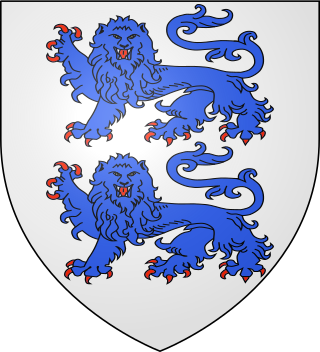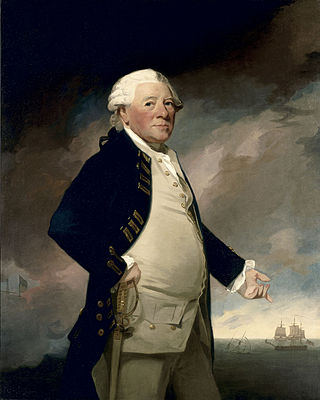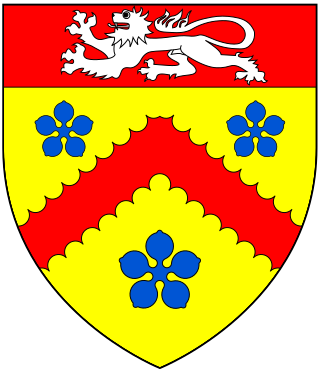
Earl of Stradbroke, in the County of Suffolk, is a title in the Peerage of the United Kingdom. It was created in 1821 for John Rous, 1st Baron Rous, who had earlier represented Suffolk in the House of Commons.
Baron Huntingfield is a title created three times, twice in the Peerage of England and once in the Peerage of Ireland. The first two creations were by writ, but little more is known about them, except that John de Huntingfield, who was created Baron Huntingfield in 1362, married Margery de Welles, daughter of John de Welles, 4th Baron Welles. John was dead by December 1376, when Margery remarried. Both titles probably became extinct or fell into abeyance on the death of their first holders. The third creation, Baron Huntingfield, of Heveningham Hall in the County of Suffolk, was created in the Peerage of Ireland in 1796 for Sir Joshua Vanneck, 3rd Baronet, Member of Parliament for Dunwich. His son, the second Baron, also represented this constituency in the House of Commons. His great-grandson, the fifth Baron, was Conservative Member of Parliament for Eye and Governor of Victoria. As of 2013 the titles are held by the latter's grandson, the seventh Baron, who succeeded his father in 1994.

There have been three baronetcies created for members of the Bacon family, all in the Baronetage of England. As of 2008, one creation is extinct and two of the creations are extant. The extant titles have been merged since 1755.

There have been seven baronetcies created for members of the Lowther family, one in the Baronetage of Nova Scotia, two in the Baronetage of England, two in the Baronetage of Great Britain and two in the Baronetage of the United Kingdom. Two of the creations are extant as of 2008.

There have been four baronetcies created for members of the Acland family, which originated in the 12th century at the estate of Acland in the parish of Landkey, North Devon, two in the Baronetage of England and two in the Baronetage of the United Kingdom.

There have been two baronetcies created for members of the Hanmer family of Flintshire, Wales, one in the Baronetage of England and one in the Baronetage of Great Britain. Only one creation is extant as of 2008. The third Baronet of the second creation was elevated to the peerage as Baron Hanmer in 1872, a title which became extinct in 1881. The family name derived from the manor of Hanmer in the Diocese of St. Asaph.

There have been two baronetcies created for members of the Trevelyan family, one in the Baronetage of England and one in the Baronetage of the United Kingdom. As of 2014, both creations are extant.

There have been two baronetcies created for people with the surname Tollemache, or Talmash, one in the Baronetage of England and one in the Baronetage of Great Britain.

There have been seven baronetcies created for persons with the surname Parker, three in the Baronetage of England, two in the Baronetage of Great Britain and two in the Baronetage of the United Kingdom. Two of the creations are extant as of 2008. Though none of the different families of baronets were related, several supplied a number of flag officers to the Royal Navy.

There have been three baronetcies created for persons with the surname Kinloch, two in the Baronetage of Nova Scotia and one in the Baronetage of the United Kingdom. Two of the creations are extant as of 2010.

The Chaytor family is an English gentry family on which has been conferred two baronetcies, one in the Baronetage of England and one in the Baronetage of the United Kingdom and several knighthoods. As of 2008 one baronetcy is extinct.

There have been two baronetcies created for the Guise family, one in the Baronetage of England and one in the Baronetage of Great Britain. The latter creation is extant as of 2014.

The Beauchamp-Proctor, later Proctor-Beauchamp Baronetcy, of Langley Park in the County of Norfolk, is a title in the Baronetage of Great Britain. It was created on 20 February 1745 for the twenty-two-year-old William Beauchamp-Proctor, subsequently Member of Parliament for Middlesex. Born William Beauchamp, he assumed the additional surname of Proctor according to the will of his maternal uncle, George Proctor, of Langley Park, Norfolk. The second Baronet married Mary Palmer, a beauty who was the subject of portraits by George Romney and Benjamin West. The third Baronet was an admiral in the Royal Navy.

There have been four baronetcies created for persons with the surname Miller, two in the Baronetage of England, one in the Baronetage of Great Britain and one in the Baronetage of the United Kingdom. Two of the creations are extant as of 2008.
There have been four baronetcies created for persons with the surname Rich, two in the Baronetage of England, one in the Baronetage of Great Britain and one in the Baronetage of the United Kingdom. As of 2008 three of the creations are extinct while one is dormant.

Bawdsey Manor stands at a prominent position at the mouth of the River Deben close to the village of Bawdsey in Suffolk, England, about 75 miles (120 km) north-east of London. Built in 1886, it was enlarged in 1895 as the principal residence of Sir William Cuthbert Quilter. Requisitioned by the Devonshire Regiment during World War I and having been returned to the Quilter family after the war, it was purchased by the Air Ministry for £24,000 in 1936 to establish a new research station for developing the Chain Home RDF (radar) system. RAF Bawdsey was a base through the Cold War until the 1990s. The manor is now used by PGL for courses and children's holidays. There is a small museum in the radar transmitter block.

The Dyke Baronetcy, of Horeham in the County of Sussex, is a title in the Baronetage of England. It was created on 3 March 1677 for Thomas Dyke, Commissioner of Public Accounts and Member of Parliament for Sussex and East Grinstead. The 2nd Baronet married Anne Hart, daughter and heiress of Percival Hart. In 1836 the 5th Baronet unsuccessfully claimed the barony of Braye, of which peerage he was a co-heir through the Hart family. The 7th Baronet was a successful Conservative politician. Percyvall Hart Dyke (1872–1952), grandson of Reverend Thomas Hart Dyke, second son of the 5th Baronet, was a Colonel in the Indian Army. His son Trevor Hart Dyke was a Brigadier in the Queen's Royal Regiment. David Hart Dyke, son of Reverend Eric Hart Dyke, son of the aforementioned Colonel Percyvall Hart Dyke, is a retired Captain in the Royal Navy and commanded HMS Coventry during the Falklands War. His daughter Miranda Hart is a well known writer, comedian, and actress.

There have been three baronetcies created for persons with the surname Cooke, two in the Baronetage of England and one in the Baronetage of Ireland. One creation is extant as of 2013.

Sir William Cuthbert Quilter, 1st Baronet was an English stock broker, art collector and Liberal/Liberal Unionist politician who sat in the House of Commons from 1885 to 1906.

Sir William Eley Cuthbert Quilter, 2nd Baronet was an English Conservative Party politician.


















